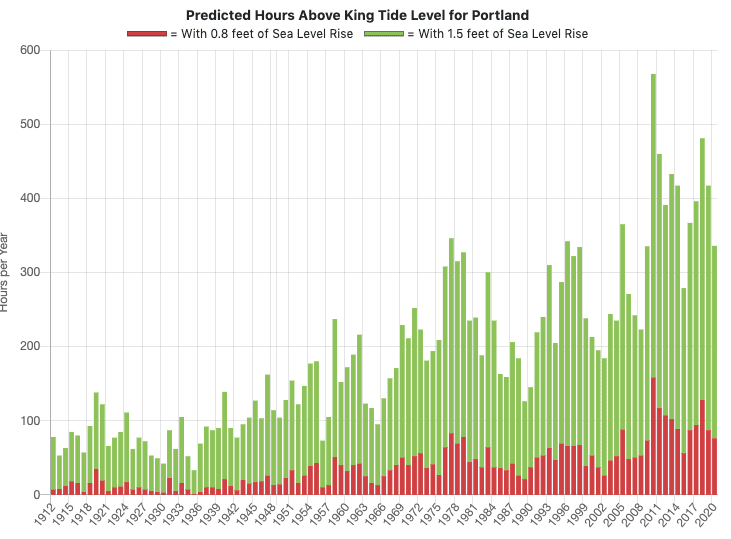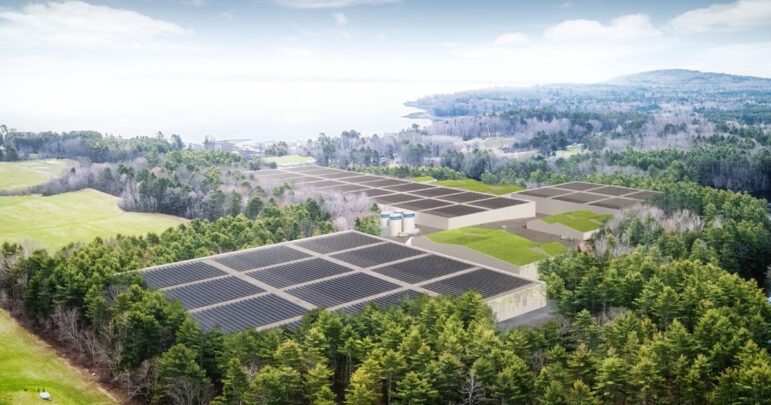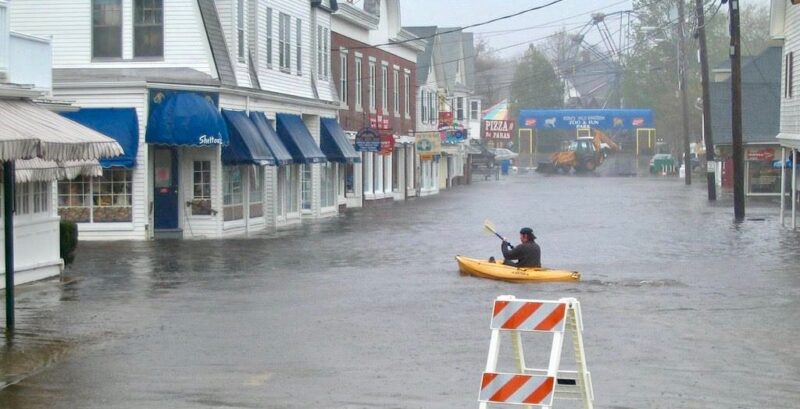A severe storm Monday night that resulted in over 100,000 power outages was followed by this winter’s first Nor’easter, which hit Maine on Saturday. The storms hammered Maine in the same week the Mills administration rolled out the state’s Climate Action Plan, Maine Won’t Wait, which outlines the need to address extreme storm and flooding events as a result of climate change.
Portions of the report highlight worsening storm-surge flooding and coastal erosion in connection to rising sea levels along Maine’s coastline. The Maine Geological Survey released an interactive sea level rise ticker and dashboard on the heels of the Climate Action Plan this week to provide the public with short- and long-term data on rising sea levels and flooding occurrences.
Stephen Dickson, a marine geologist with the Maine Geological Survey, helped create the tracking tools and also co-authored the chapter on storm surges and sea level rise for the Maine Climate Council’s Science and Technology subcommittee. Since 2010, Dickson and his colleagues found that sea levels have inched further from their historical average.
“All of a sudden the water’s much higher than it’s been in the past,” said Dickson. “The water is creeping up slowly but surely.”

The data shows sea levels rising 0.8 feet by 2030 based on trends since 2000. An increase in sea level of 1.5 to 1.6 feet by 2050 would result in the loss of 40 percent of Maine’s beaches, Dickson said. The data also shows an increase in the number of hours of flooding experienced in Maine each year, which has huge economic repercussions.
“Unaddressed sea-level rise and repeated storm-surge flooding could cost Maine $17.5 billion in building damage from 2020 to 2050,” according to the Climate Action Plan. While storm-surge flooding is common with Nor’easters, a continued rise in sea levels could mean more flood damage from less severe storms.
“If we get a certain amount of storm surge, if the sea level is higher, it’s just that much more water that you would see from flooding,” said Michael Clair, a meteorologist with the National Weather Service in Gray. “It’s just kind of luck of the draw when storms hit.”
Clair and his colleagues forecast the weather on a weekly basis and watch for storms that coincide with high tide events — or astronomical tides — that happen monthly during a three- to five-day period when the moon is full and tides approach 10 feet.
The period of highest tides this month will occur from the 13th to the 17th, with tides expected to reach 11.6 feet on Dec.14 and 15.
“We’d be much more concerned if we were getting a storm around (Dec.) 14 and 15,” said Clair. When large storms coincide with astronomical high tide events, scientists fear flooding could be catastrophic.
“If we have another year or two where the winter sea levels are higher, that means that it’s a lot easier for the storms to cause flooding and to cause damage along the coast,” said Dickson. “(If) the timing of this peak in the storm surge happened at high tide, we could be in for a storm like we’ve never seen before.”
Dickson points to the Blizzard of 1978, which wiped out the pier at Old Orchard Beach with a large storm surge and a high tide that rose to 14.17 feet. More recently, Maine saw a storm in October 2019 that featured a four-foot plus storm surge that missed the high tide event by just a couple of hours.
Dickson sees the recent close calls as superstorm warning signs with the power to produce an event similar to Hurricane Sandy, which devastated the Atlantic coast in 2012, taking 233 lives and costing $70 billion in damages.
“(A superstorm) kind of could happen any day, it’s just a matter of chance,” said Dickson.
Community concerns over AT&T cell phone tower in Weld
Community members in the Franklin County town of Weld are waiting for an opportunity to voice their concerns to the town appeals board over the proposed location of a 190-foot cell phone tower overlooking Webb Lake near Mount Blue State Park and Tumbledown Mountain.
The Weld planning board approved the building permit for the tower on Sept. 9 and an appeal was filed Oct. 8. The project is designed to expand emergency response networks in rural areas and is partially funded by FirstNet, an initiative of the U.S. Department of Commerce and AT&T.
“We’re not trying to prevent the tower from coming, we think it should be in a different place,” said John Stifler, a homeowner who spends his summers in Weld and is part of the opposition group appealing the decision.
Citizens and homeowners opposing the tower location have voiced concerns about potential environmental impacts, property values decreasing, and a lack of zoning regulations in Weld that resulted in the project being approved.
Earlier this year, Lauren Abbate of the Bangor Daily News reported that a company affiliated with AT&T sued the city of Rockland after the city council rejected a similar proposal for a 120-foot cell phone tower. Less than a month ago, Rockland settled with the company by allowing it to erect the disputed monopole according to plan.
The city council released a statement highlighting its attempts to fight the proposal through legal means and were advised by their lawyers the case was not winnable so it settled.
“Please know that even if our Ordinances had been strengthened before Bay Communications came looking, we still would not have been able to prevent them from putting up a tower in Rockland,” part of the statement read. “We might have been able to modify the consequences a little, but we cannot prevent towers completely because of protections that Federal laws provide for telecommunications.”
The Federal Telecommunications Act of 1996 does not allow city zoning ordinances to prevent providers from closing significant gaps in service. As concerned community members in Weld await their date with the town’s appeals board, they are anticipating and preparing for challenges ahead.
“The corporation knows what it wants, and it’s got its routine, and it’s got its full-time professionals working on it,” said Stifler. “We have to decide how much money and time and energy we’ve got to make a court case out of it.”
$500 million midcoast aquaculture project puts intertidal ownership into question
The proposed $500 million Nordic Aquafarms aquaculture project scheduled for the midcoast continues to face controversy over land rights associated with laying saltwater intake and wastewater discharge pipes from the proposed facility — through a privately owned portion of the Belfast intertidal zone — and out into Penobscot Bay.
The debate over who owns the tidal rights to construct a 30-foot wide swath to lay pipes continues; legal challenges and permit approvals remain pending. Maine is one of two states that grants private property owners ownership of the intertidal zone.

“It comes down to, well, who owns that intertidal zone?” said Andy Stevenson, secretary for the Friends of Harriet L. Hartley Conservation Area, a nonprofit advocacy group challenging the pipeline route in court. “If Nordic does not have the legal right to cross that intertidal zone, it would either have to lay its pipeline somewhere else, or it would have to abandon the project.”
A cluster of neighbors living on beachfront property disagree on who owns the prime intertidal zone, a boundary dispute that will be decided by a Waldo County superior court judge. While the land remains the preferred route for Nordic Aquafarms, the company said it always considers alternatives.
“We have a preferred route but there are other options as well,” said Marianne Naess, a spokesperson for Nordic Aquafarms. “We’re in it for the long run and we’ve been fighting hard in Belfast for over the last two years.”
The Belfast planning board will continue deliberations on the five municipal permits needed for construction over the next two weeks.
Nordic Aquafarms received final state permits from the Department of Environmental Protection on Nov. 19 and the public has 30 days to appeal. A federal permit from the Army Corps of Engineers is also required.
“The issuing of the permits is one prerequisite for Nordic being able to construct its plants, but securing permission to cross the intertidal zone is the other prerequisite,” said Stevenson. “If they don’t have permission to cross the intertidal zone, they can’t put their plant there.”
Emergency funds to assist Maine farmers during pandemic
The Maine Farmland Trust and Maine Organic Farmers and Gardeners Association (MOFGA) announced the opening of a second round of emergency grants for farmers impacted by the COVID-19 crisis.
The application was designed to be more inclusive in hopes of broadly offering support to farmers experiencing financial challenges as they transition to changes in their operations due to market demands and coronavirus regulations.
“We’re hearing more from farmers that there’s so much uncertainty right now,” said Ryan Dennett, MOFGA’s farmer programs director. “While $2,000 is small, it can allow them to take on that risk to expand production.”
Dennett noted many farmers have to buy warmer clothing and invest in propane heaters to keep themselves and their products from freezing as they transition to COVID-friendly outdoor farmers markets. The grants aim to reimburse for expenses incurred from revenue losses and changes in operation.
The expanded application is open to farmers who have not participated in Maine Farmland Trust or MOFGA programs. These applicants can only apply if they are beginning farmers — those operating for less than 10 years — or a farmer from an underrepresented community of color who identifies as Black, Indigenous or a person of color.
“We understand everyone is impacted,” said Dennett. “Where there’s so much uncertainty it helps (farmers) a bit.”
Grant applications are due Dec. 14 and awards are expected to be announced during the week of Dec. 21.
Editor’s Note, Dec. 7, 2 p.m.: An earlier version of this story misstated the projected rate of sea level rise as 0.8 feet per year. The story has been updated to reflect that sea level is expected to rise 0.8 feet by 2030.
Dec. 8, 4:30 p.m.: An earlier version of this story incorrectly stated that the Belfast planning board wrapped up deliberations on five permits for the Nordic Aquafarms project and would give recommendations to the city council for its final votes. The story has been updated to reflect that the planning board’s deliberations are not yet over. The planning board, not the city council, will have final say on the permits.




